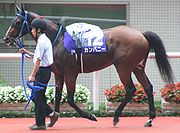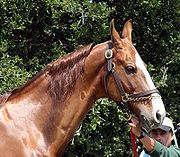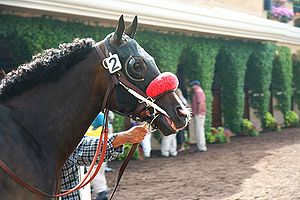.gif)
Lead (tack)
Encyclopedia


Horse
The horse is one of two extant subspecies of Equus ferus, or the wild horse. It is a single-hooved mammal belonging to the taxonomic family Equidae. The horse has evolved over the past 45 to 55 million years from a small multi-toed creature into the large, single-toed animal of today...
. Usually, it is attached to a halter
Halter
A halter, headcollar, or, less often, headstall, is headgear that is used to lead or tie up livestock and, occasionally, other animals; it fits behind the ears , and around the muzzle. To handle the animal, usually a lead rope or lead shank is attached...
. The lead may be integral to the halter or, more often, separate. When separate, it is attached to the halter with a heavy clip or snap so that it can be added or removed as needed. A related term, lead shank or lead chain refers to a lead line with a chain attached that is used in a variety of ways to safely control possibly difficult or dangerous horses if they will not respond to a regular lead.
Variations
A lead can be made from a variety of materials, including cottonCotton
Cotton is a soft, fluffy staple fiber that grows in a boll, or protective capsule, around the seeds of cotton plants of the genus Gossypium. The fiber is almost pure cellulose. The botanical purpose of cotton fiber is to aid in seed dispersal....
, horsehair (woven or braided hair, usually from a horse's tail), leather
Leather
Leather is a durable and flexible material created via the tanning of putrescible animal rawhide and skin, primarily cattlehide. It can be produced through different manufacturing processes, ranging from cottage industry to heavy industry.-Forms:...
, nylon
Nylon
Nylon is a generic designation for a family of synthetic polymers known generically as polyamides, first produced on February 28, 1935, by Wallace Carothers at DuPont's research facility at the DuPont Experimental Station...
or other synthetic materials. Lead ropes, as the name implies, are round and made of various types of rope, usually between 5/8 and 3/4 inch (about 2 cm) in diameter. Lead lines are usually flat webbing or leather, and are generally 0.75 to 1 in (1.9 to 2.5 cm) wide, though may be narrower for show use. Flat lines are less bulky and more comfortable in the hand for leading and animal, but may lack adequate strength for tying.
A lead most often attaches to the halter with a sturdy snap. In some cases, the lead is tied or spliced
Rope splicing
Rope splicing in ropework is the forming of a semi-permanent joint between two ropes or two parts of the same rope by partly untwisting and then interweaving their strands. Splices can be used to form a stopper at the end of a line, to form a loop or an eye in a rope, or for joining two ropes...
permanently to the halter. A lead for a horse usually is in the range of 9 to 12 ft (2.7 to 3.7 m) long, but longer and shorter lengths are seen.
The lead shank consists of a lead, usually a flat line, with a chain end, or, less often, thin nylon or rope. The chain end ranges from 18 to 30 in (45.7 to 76.2 cm) long and has a snap or clip on the end that attaches to the halter, and a ring on the other end that is attached to the lead line. Some lead lines are permanently sewn to the chain shank, others have buckles or clips allowing the chain to be removed. Lead shanks are usually used on potentially difficult or dangerous horses, such as stallion
Stallion (horse)
A stallion is a male horse that has not been gelded .Stallions will follow the conformation and phenotype of their breed, but within that standard, the presence of hormones such as testosterone may give stallions a thicker, "cresty" neck, as well as a somewhat more muscular physique as compared to...
s or those that, for various reasons, will not respond to a regular lead. For this reason, in some regions, lead shanks are sometimes called "stud chains." They are also commonly seen on in-hand
Halter (horse show)
"Halter" is a term used to describe a type of horse show class where horses are shown "in hand," meaning that they are led, not ridden, and are judged on their conformation and suitability as breeding stock...
horses of all ages and sexes at some horse show
Horse show
A Horse show is a judged exhibition of horses and ponies. Many different horse breeds and equestrian disciplines hold competitions worldwide, from local to the international levels. Most horse shows run from one to three days, sometimes longer for major, all-breed events or national and...
s, as the chain shank can also be used to transmit commands quickly but inobtrusively, encouraging a prompt response from the horse.
For aesthetic purposes, the lead may be the same color as the halter, and sometimes even made of the same materials.
Use
Leads are used to lead, hold, or tie an animal or string of animals. A horse may be led by a person on the ground, sometimes called "leading in-hand," or may be led by a rider mounted on another horse, a process called "ponying." A "string" of animals refers to animals tied to one another by their leads, whether the human leads the horses in hand or from another horse. Horses requiring physical conditioning, such as Polo poniesPolo pony
A polo pony is the term used for a horse used in the game of polo. They may be of any breed or combination of breeds, though many have a significant amount of Thoroughbred breeding. They are called "ponies", but that is in reference to their agile type rather than their size...
or roping horses
Steer roping
Steer roping, also known as steer tripping, is a rodeo event that features a steer and one mounted cowboy.The steer roper is behind a taut rope fastened with an easily broken string which is fastened to the rope on the steer. When the roper is ready he calls for the steer and the chute man trips a...
, may be conditioned in strings. Pack horses are often led in strings on the trail, usually with the handler ponying the first pack horse and for the rest, the lead rope of one horse is tied to the tail or saddle of the horse in front of it.
Safety in leading

When leading a horse, the handler usually holds a single thickness of the lead with the right hand, while carrying the gathered slack of the lead in the left. The excess line is usually gathered in loops; wrapping or coiling the lead around the hand is dangerous, the handler can be injured or dragged if the horse pulls away, tightening the lead around the hand.
When used to lead a horse in hand, the materials used in a lead, particularly synthetics, may put a handler at risk of a rope burn should the horse pull the lead from the handler. Some handlers wear gloves while leading a horse.
Tying

Halter hitch
The halter hitch is a type of knot used to connect a rope to an object. As the name implies it is useful in tying the lead rope, which is attached to the halter, to a post or hitching rail. The benefit of the halter hitch is that it can be released by pulling on one end of the rope. Even if...
and a subset of other loop knots, collectively known among equestrians as safety knots and quick release knots. If the animal begins to panic, a person can pull the working end
Knot
A knot is a method of fastening or securing linear material such as rope by tying or interweaving. It may consist of a length of one or several segments of rope, string, webbing, twine, strap, or even chain interwoven such that the line can bind to itself or to some other object—the "load"...
to quickly release the knot before it becomes too tight to untie quickly. The purpose of such a knot is to be easy to untie even when under significant tension. However, some animals do learn to untie themselves and may require the loose end of the rope to be passed through the slipped loop
Bight (knot)
In knot tying, a bight is a curved section, slack part, or loop between the two ends of a rope, string, or yarn. The term is also used in a more specific way when describing Turk's head knots, indicating how many repetitions of braiding are made in the circuit of a given knot.-Slipped knot:In order...
to prevent this occurrence, or be tied with alternative methods of restraint.
Animals, usually horses, may also be placed in crossties, usually for grooming
Horse grooming
Horse grooming is hygienic care given to a horse, or a process by which the horse's physical appearance is enhanced for horse shows or other types of competition.-Reasons for grooming:...
, tacking up
Horse tack
Tack is a term used to describe any of the various equipment and accessories worn by horses in the course of their use as domesticated animals. Saddles, stirrups, bridles, halters, reins, bits, harnesses, martingales, and breastplates are all forms of horse tack...
and related activities. Crossties are commonly made from two lead ropes, each attached to a wall with the snap end placed on either side of the horse's halter. This technique of restraint keeps the horse from moving around as much as with a single lead, and is particularly handy when people are working on both sides of the animal. However, the method also presents some danger to the animal if it rears
Rear (horse)
Rearing occurs when a horse or other equid "stands up" on its hind legs with the forelegs off the ground. Rearing may be linked to fright, aggression, excitement, disobedience, or pain. It is not uncommon to see stallions rearing in the wild when they fight, while striking at their opponent with...
or falls. Ideally, crossties are attached at one end with either a quick release panic snap
Panic snap
In horse tack, a panic snap is a mechanism often used between a lead and a horse harness or halter. They are useful because, unlike swivels or carabiners and similar fittings, they can be disconnected under load, as the panic snap is specially built so that the latching mechanism is separate from...
or breakaway mechanism.
Flat lead shanks and thin diameter ropes generally lack the strength to securely tie a large animal such as a horse or cow, but may be more comfortable in a person's hand for leading. Ropes of a thick diameter (3/4 in or more) and high tensile strength generally are adequate to tie a large animal that resists being tied; thinner and/or weaker leads generally will break if significant tension is put on them. A common point of failure is the snap fastener
Snap fastener
A snap fastener is a pair of interlocking discs commonly used in place of buttons to fasten clothing. A circular lip under one disc fits into a groove on the top of the other, holding them fast until a certain amount of force is applied...
used to attach the lead to the halter.
An animal that panics and attempts to escape while tied with a lead can cause itself serious injury or damage the objects to which it is tied. When an animal is left unattended or if a safety knot is improperly tied and cannot be released, views differ as to whether a lead rope should be made strong enough not to break under tension, or if it should have safety elements that allow it to give way when tension reaches a certain point in order to minimize potential injury. Some people carry a very sharp knife in a belt holster or boot or keep a sharp knife in a convenient location in order to cut a lead in case of emergency. In other cases, particularly on leads used to restrain an animal in a horse trailer
Horse trailer
A horse trailer or horse van is used to transport horses...
, a panic snap
Panic snap
In horse tack, a panic snap is a mechanism often used between a lead and a horse harness or halter. They are useful because, unlike swivels or carabiners and similar fittings, they can be disconnected under load, as the panic snap is specially built so that the latching mechanism is separate from...
may be used, though releasing the snap while under extreme tension also may put a handler at some risk of injury.
Use of a shank


Rear (horse)
Rearing occurs when a horse or other equid "stands up" on its hind legs with the forelegs off the ground. Rearing may be linked to fright, aggression, excitement, disobedience, or pain. It is not uncommon to see stallions rearing in the wild when they fight, while striking at their opponent with...
. Light, short tugs are generally enough to get the attention of a horse. The chain should only come into action when pulled, not when hanging loosely. The handler does not hold the chain itself, as it can hurt the handler's hands should the horse pull back or move its head quickly.
Chain shank attachments
- Over the nose: The shank is run through the left ring of the halter (on the side of the face), wrapped once around the noseband of the halter, threaded through the right side nose ring of the halter, and attached on the upper right ring of the halter (near the ears of the horse). In some places, this configuration is called a "stallion chain," though the setup is used on horses of all sexes under some circumstances. If the chain is not attached to the upper right ring, the halter can slide into the horse's eye when the shank is applied. When pressure is applied, the shank puts pressure on the nose of the horse, encouraging the animal to become more aware of the handler's signals. If the shank is used harshly, the handler can damage the horse's nose. An alternative use is to take the chain over the nose, around and under the chin, and attached back to itself.
- Under the chin: the shank is run through the lower left ring of the halter, under the chin, through the lower right ring of the halter, and attached either back to itself or to the upper right ring. This tends to make a horse raise his head, but also has a stronger disciplinary effect. The chain, if too short to be attached back on itself, can also be run through the left ring and attached to the right ring, though the halter may also be moved off-center when the shank is applied, and the snap may be subject to pressure that may cause it to fail.
- Chain through mouth: The chain is run through the left lower ring, through the mouth, through the right lower ring, and attached to the upper right ring. This is quite severe and can damage the mouth if used harshly.
- Chain over gum: similar to the chain through the mouth, except the chain is rested on the upper gum of the horse's mouth, under the upper lip. The most severe attachment, may cause bleeding if the horse resists.
See also
- Longe line
- ReinReinReins are items of horse tack, used to direct a horse or other animal used for riding or driving. Reins can be made of leather, nylon, metal, or other materials, and attach to a bridle via either its bit or its noseband.-Use for riding:...
- Lead (leg)Lead (leg)Lead refers to which set of legs, left or right, leads or advances forward to a greater extent when a quadruped animal is cantering, galloping, or leaping. The feet on the leading side touch the ground forward of its partner. On the "left lead", the animal's left legs lead...
- Lead change

